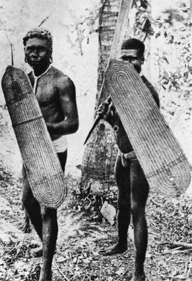
Shields from the Solomon Islands
(p31)
The Western Islands: Santa Isabel, Choiseul, New Georgia group
South of the Bougainville Straits, the New Georgia Islands, Choiseul and Santa Isabel form a distinctive and broadly-speaking homogeneous art-producing region where decorated canoes and canoe ornaments, weapons and carved spirit images once constituted major art forms. Fewer details are available about art in its ritual context for the region, in comparison with islands to the northwest and southeast, owing to the amount of inter-islands warfare which mitigated contact with Europeans. ...
The excess of war and, in particular, head-hunting provided a strong impetus for the production of carvings in [this] area. .. . Headhunting ceased near the end of the 19th century as a result of prohibitions made by the British navy and colonial administrators. Accordingly the art production that was so intimately associated with war gradually declined ...
Clubs and shields take regular ovoid or angular shapes. Whether embellished or not, their design is one of restraint and symmetry with a feeling of elegance ...
(p120 - 121)
... [An] elliptically shaped fighting shield is made of coiled pieces
of cane bound with horizontal lashing. A loop handle of cane is
attached to the reverse side of the shield.
Wicker fighting shields of this general type were once utilized in the New Georgia Islands, Santa Isabel, Guadalcanal, and Florida Islands. ...
Wicker shields used in the above-mentioned islands were reputedly made only in certain places. Inhabitants of the interior of Guadalcanal Island have been reported to have been producers of wicker shields which they then sold to other islanders (Edge-Partington, 1906: 129).
Lieutenant Boyle Somerville, the British naval officer who was in the Marovo Lagoon, Roviana Island from 1893 - 1894 mentions a village in the Marovo Lagoon where wicker shields were manufactured:
The lave lave, or shields, are ... made of basket-work. In New Georgia, as far as I could discover, these are made in one village only - Pondokona - and are now exceedingly difficult to procure, at least we found them so. They are of a long elegant shape, and so strong and closely woven that they will easily turn a spear thrust. The same old pattern appears on all of them, stained in black after the shield is made, and not woven in at the time. It is carried with the smaller end up by a padded handle at the back, and the handhole is often further protected by a piece of turtle shell, or several pieces of large leaf, stuck between it and the back of the shield. There is a small feather plume stuck into the top. (Somerville, 1897: 374)
In the same article, Somerville subsequently notes that:
Shields .... are made in one or two villages and are a valuable possession. These are made not only of basketwork, but also of wood ornamented with black, white and red patterns; perhaps these are only for sale to white people, or for dancing purposes. They are used more to parry a blow with than as a steady protection to the whole body, of which indeed they only actually cover a small portion. (Somerville, ibid: 401)...
...Elliptical wicker fighting shields were once used in battle by the people of Guadalcanal, Florida, Santa Isabel and the New Georgia Islands. Leading producers of many of these shields lived in the interior of Guadalcanal (Codrington, 1891: 305, Edge-Partington, 1906: 129).
The [shield in the Barbier-Muller collection she is discussing] is one of a group of elaborately decorated wicker shields whose surfaces have been colored black and red and heavily embellished with rows of small pieces of nautilus shell set in parinarium net glue [Note that the Screen 2 shields are NOT decorated with shell inlay in this way]. Only about twenty of these shields exist today in museums and private collections. There are, in addition, five known rectangular bark shields decorated in a similar manner [of which one is in the Pitt Rivers Museum]. The shell inlay appears likely to be the work of Isabel islanders. ... No known examples of shell inlaid shields exist in the Solomon Islands today, nor were they ever viewed in use by 19th century visitors to the islands.
... The function of these elaborately inlaid shields is unknown, but their beauty and fragile nature would suggest a ceremonial function and preclude battle use. Each inlaid shield has a uniqueness of design revealed in the presence or absence of small detached heads ... or some other feature - a uniqueness which would perhaps suggest or reflect exclusive ownership by a big man or other important community leader.

Warriors from Roviana (New Georgia) with undecorated wicker shields (R. Festetics de Tolna 1903: p328)